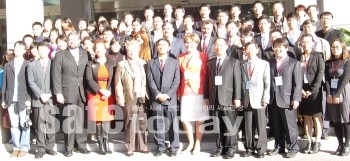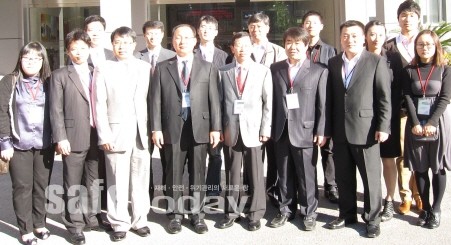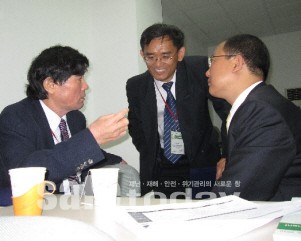한국, 미국, 중국, 일본, 러시아, 스웨덴, 콜롬비아, 이란, 이라크, 체코 모두 10개국 위기관리 전문가들의 국제 학술대회인 제4회 ICCEM(The 4th International Conference on Crisis and Emergency Management)과 중국 자체의 제2회 국제 학술대회인 EMTAP(The 2nd International Conference on Emergency Management : Technology, Application and Practice)가 지난 10월15일부터 17일까지 3일간의 일정으로 중국 베이징 중국과학원(CAS ; Chinese Academy of Science)에서 동시에 개최됐다.

한국 내 국가위기관리학회(회장 이재은 충북대 교수, www.kacem.or.kr)가 ISCEM의 본부(www.iscem.net)를 맡고 있다. 재난, 재해, 안전, 위기관리 분야의 순수 민간 국제기구의 본부를 한국에서 맡고 있는 경우는 매우 드문 일이다.
ISCEM의 임원(The President Board Members)은 한국 대표인 이재은 충북대학교 교수, 중국 대표인 안 첸(An Chen) 중국과학원 교수, 일본 대표인 노리오 오카다(Norio Okada) 교토대학교 교수(방재연구소장), 미국 대표인 자넷 딜링(Janet D. Dilling) 프로리다주립대학교 교수(재난위험정책센터 명예이사(Center for Disaster Risk Policy, Director Emeritus))이다.

이번 ICCEM 행사는 ISCEM(2010년 회장, 안 첸, 공동회장 노리오 오카다, 이재은) 주최 하에 중국과학원, 국가위기관리학회, 충북대 국가위기관리연구소, 교토대 방재연구소 등이 공동으로 주관해 열렸다.
이번 ICCEM 행사가 제2회 EMTAP와 함께 개최된 관계로 중국 측에서 가장 많은 재난, 재해, 안전, 위기관리 분야 전문가들이 대거 참여했다. 중국이 65명, 한국이 16명, 미국이 4명, 일본, 러시아, 이라크가 각각 2명, 스웨덴, 콜롬비아, 체코, 이란이 각각 1명씩 참여하는 등 모두 100여명이 행사장을 지켰다.
이번 ICCEM은 지난 10월15일 오전 오프닝 행사에 이어 오전 키노트 스피치(4편의 논문)와 오후 초대 스피치(8편의 논문), 16일 오전 통합 스피치(7편의 논문)와 오후 두 세션 스피치(16편의 논문), 17일 오전 두 세션 스피치(8편의 논문)로 나눠 진행됐다.
총 43편의 논문이 발표된 이번 행사는 3편에서 4편씩의 논문발표를 진행하는 사회자의 사회에 따라 발표자가 발표하고 지정된 토론자가 논문에 대해 지적하고 입장을 밝힌 후 참석자들과 발표자간의 질의응답 형태로 추진됐다.

이번 ICCEM 행사에는 이재은 충북대 교수가 ‘위기 시 커뮤니케이션 전략: 전 세계 재난관리에 있어서 효과적인 조정을 중심으로(Crisis Communication Strategy is Needed: the Effective Cooperation and Coordination in Global Crisis and Emergency Management)’, 첸 안 중국 중국과학원 교수가 ‘사고평가 전략과 방법(During-incident Assessment Strategy and Method)’, 아우드레이 헤프론 캐설라이(Audrey Heffron-Casserleigh) 미국 프로리다주립대(Florida State University) 교수가 ‘공공 보건 재해에 있어서 시민들의 기대관리(Managing Citizen Expectations in Public Health Disaster)’, 코크로바(M.N. Khokhlova) 러시아 CEFEY 전무이사(Executive Director)가 ‘다중 위기의 인터넷 중심관리(Multy-crisic Net Centric Management)’란 주제의 논문을 발표했다.
다음은 이번 행사에서 발표된 논문 현황이다.
▲ 피트 테플리(Petr Teply) 체코(Czech Republic) 찰레대학교(Charles University) 박사의 ‘2007년부터 2009년까지의 세계경제 혼란을 통해서 본 유동성 리스크 관리의 중요성(The Importance of Emergency Liquidity Risk Management during The 2007-2009 Global Financial Turmoil)’
▲ 에바-카린 올선(Eva-Karin Olsson) 스웨덴 룬드대학교(Lund University) 박사의 ‘전세계적인 위기관리 경험 - SARS 사례를 중심으로(Transboundary crisis management practices – The case of SARS)’
▲ 자넷 딜링(Janet Dilling) 미국 프로리다주립대학교(Florida State University) 박사의 ‘구조 체계 : 명령과 조정의 질문(Structural Systems: The Command vs. Coordination Question)’
▲ 치 페이(CHI Fei) 중국 중국과학원(CAS) 재난관리연구소(Institute of Policy and Management) 박사의 ‘사회 물리적인 부분인 부분에 기초를 둔 재난관리 메커니즘(The mechanism of emergency management based on the social physics)’
▲ 아델 카말 키덜(Adel Kamal Khider) 이라크 살라하딘대학교(University of Salahadeen) 교수의 ‘질경이에서 포도산구균 추출(Activity of Plantago lanceolata Extracts Against Methecillin Resistance Staphylococcus aureus In Vitro and In Vivo)’
▲ 송 얀(SONG Yan) 중국 하얼빈공과대학(Harbin Engineering University) 교수의 ‘H1N1독감을 위한 하얼빈 공과대학 재난관리시스템 설립(Construction of the Harbin Engineering University Emergency Management System for the Type A H1N1 Flu)’
▲ 시민독트 네마톨라이(Simindokht Nematollahi) 이란 BAGH SHAHR BANA 컨설팅 엔지니어(Consulting Engineers) 박사의 ‘도시 빈곤과 환경 위기 사례의 연구와 분석(Study and analysis of urban poverty and environmental risks Case study: Tabriz)’
▲ 김지은 충북대 대학원 석사과정, 윤진영, 김진백, 강은지, 여희경 충북대 학부생 공동의 ‘미국과 한국의 위기와 재난관리 비교분석(Comparative Analysis of the Crisis and Emergency Management System between USA and Korea)’
▲ 노리오 오카다(Norio Okada) 교토대(Kyoto University) 교수의 ‘참여접근법을 포함한 재해 감소를 위한 분야와 사회적인 이행의 과제(Multi-sector Involved Participatory Approaches for Disaster Reduction and Challenges towards Social Implementation)’
▲ 데이비드 F. 메릭(David F. Merrick) 미국 프로리다주립대(Florida State University) 부디렉터(Deputy Director)의 ‘재해 전에 특별히 필요한 부분들(Pre-disaster Special Needs Registries)’
▲ 딜솨드 간조 아마드 간조(Dilshad Ganjo Ahmad Ganjo) 이라크 살라하딘대학교(University of Salahadeen) 교수의 ‘폐수의 관개 목적을 위한 생물학적 청정기로 수생 일부를 사용(Phytoremediation of Wastewater Using Some of Aquatic Macrophytes as Biological Purifiers for Irrigation Purposes)’
▲ 리 닝(LI Ning) 미국 괌대학교(University of Guam) 교수의 ‘구암지역에서 정부대응과 관광 위기관리(Government Responsiveness and Tourism Crisis Management in Guam)’
▲ 강 은팡(QIANG Enfang) 중국 텐진사범대학교(Tianjin Normal University) 교수의 ‘중국과 한국에서 기름유출 대응분석을 위한 분석 틀(A Stakeholder Framework for Comparative Analyzing Oil Spill Response in China and Korea)’
▲ 일리아나 허난데즈(Iliana Hernandez) 콜롬비아 Pontificia Universidad Javeriana 박사의 ‘재난, 바이오테크놀러지와 창조적인 시스템(Emergency, Biotechnology and Creative Systems)’
▲ 우 야난(WU Yannan) 중국 산동대학교(Shandong University) 연구원의 ‘재난관리에서 지배 메커니즘 설계이론 적용의 틀과 모델(Framework and Modes of Managerial Mechanism Design Theory with Applications in Emergency Management)’
▲ 추 쭈지에(CHU Zhujie) 중국 하얼빈공정대학교(Harbin Engineering University) 교수의 ‘하얼빈에서 토양자원 위기관리의 운반 능력(Carrying Capacity of Land Resources Crisis Management in Harbin)’
▲ 리우 리앙(LIU Liang) 중국 전자과학기술중국의대학(University of Electronic Science and Technology) 교수의 ‘자유로운 재난 연구의 생각(Thoughts about the Research of Unconventional Emergency)’
▲ 최희천 한국 서울시립대(The University of Seoul) 투명도서울연구소(Seoul Institute for Transparency) 연구원의 ‘재해연구를 위한 포괄적이고 효과적인 전통적 접근(Toward Comprehensive Effect Oriented Perspective for Disaster Studies)’
▲ 왕 지양(WANG Ziyang) 중국 베이징교통대학교(Beijing Jiaotong University) 박사의 ‘철도 재난계획의 이행효과를 평가할 수 있는 방법(A Method to Evaluate the Implementation Effect of the Railway Emergency Plan)’
▲ 마 잉난(MA Yingnan) 중국 도시시스템엔지니어링의베이징연구센터(Beijing Research Center of Urban System Engineering) 교수의 ‘식물뿌리 군집의 재난관리시스템 모델 분석(Analysis of Grass-roots Communities’ Emergency Management System Model)‘
▲ 송은진 한국 충북대 연구원의 ‘한국, 중국, 일본, 미국에 있어서 소비의 안전 추구 행동 모델에서 국내 비교(Inter-Country Comparison on Model of Consumers' Safety Pursuit Behavior in Korea, China, Japan, and the USA)’
▲ 후 쳉(HU Cheng) 중국 노동보호베이징시연구소(Beijing Municipal Institute of Labour Protection) 연구원의 ‘대단위 위험의 감시와 조기 경고(Monitoring and Early caution of Crowd Risk)’
▲ 리 지메이(LI Jimei) 중국 IPMCAS 연구원의 ‘다양한 프로그램 개발에 기초한 평가와 적용(Mitigability Measurement and Application based on Dynamic Programming)’
▲ 히룬사리 니아니(Hirunsalee Siyanee) 일본 리츠메이칸글로벌혁신연구기관(Ritsumeikan Global Innovation Research Organization) 연구원의 ‘홍수 재해에 대피 의사결정의 거주자 인지에 있어서 잠재 요소들 영향(Latent Factors Influence on Resident Perception of Evacuation Decision Making in Flood Emergency)’
▲ 왕 야우이(WANG Yahui) 중국 토목공학및건축베이징대학(Beijing University of Civil Engineering and Architecture) 교수의 ‘재난관리에 있어서 정보 보급의 연구(The Study of Information Dissemination Law in Emergency Management)’
▲ 배천직 한국 전국재해구호협회(Korea Disaster Relief Association) 과장(가톨릭대학교 박사과정 중)의 ‘자연재해에 있어서 취약성 분석(Analysis of Vulnerability on Natural Disaster )’
▲ 탕 타이(TANG tian) 중국 청화대(Tsinghua University) 연구원의 ‘유행성 독감을 위한 정부와 국민간의 위기 소통전략(The Risk Communication Strategies between Government and the Public for Pandemic Influenza: Lessons from the Risk Communication of Beijing Government in Pandemic A (H1N1) 2009)’
▲ 샹 징푸(SHANG Jingfu) 중국 국가그리드(State Grid) 박사의 ‘중국에서 대단위 정전을 위한 재난관리: 개발과 현재의 입장에서(Emergency Management for Great Blackout in China: Development and Current Status)’
▲ 장 지안웬(ZHANG Jianwen) 중국 화학기술의베이징대학(Beijing University of Chemical Technology) 교수의 ‘위험한 화학 사고의 비용산정(Cost Calculation of Hazardous Chemical Accidents)’
▲ 니 후이후이(NI Huihui) 중국 노동보호베이징시연구소(Beijing Municipal Institute of Labour Protection) 연구원의 ‘리스크 메트릭스 분석과 시사점(Risk Matrix Analysis and some Extensions)’
▲ 변성수, 이주호 한국 충북대 연구원(박사)의 ‘영향요인에 의한 갈등관리 모델 정립연구(A Study of Building Conflict Management Model by Influencing Factor)’
▲ 젱 쉬앙양(ZHENG Xiaoyang) 중국 산동대학교(Shandong University) 연구원의 ‘항공기 연착의 확산 메커니즘 연구(Analysis of Spread Mechanism of Flight Delay)’
▲ 박대우 한국 충북대 연구원의 ‘재난 대응에 대한 소방공무원의 인식(Perception of the Fire Fighters about Disaster Response)’
▲ 왕 구안구희(WANG Guanghui) 중국 IPMCAS 연구원의 ‘위기관리에 있어서 지위체계 설계(Design of Command Mechanism in Emergency Management)’
▲ 젠 지펭(Zheng Jinpeng) 중국 노동보호베이징연구소(Beijing Municipal Institute of Labour Protection) 연구원의 ‘비용산정 해결 가능성과 필요성 관계에 관한 연구(The Relationship between Possibility and Necessity in Assessment Model of Solvability)’
▲ 장 하오우(ZHANG Haoyu) 중국 IPMCAS 연구원의 ‘게임이론과 위기관리의 적용(Game Theory and Its Application in Emergency Management)’
▲ 김진백, 강은지, 윤진영, 여희경, 김지은 한국 충북대 연구원의 ‘미국과 한국의 위기관리 시스템 비교연구(Comparative Analysis of the Crisis and Emergency Management System between USA and Korea)’
▲ 닝 니준(NING Lijun) 중국 노동보호베이징시연구소(Beijing Municipal Institute of Labour Protection) 연구원의 ‘위기관리의 진화(The Evolution Mechanism of Emergency)’
▲ 리우 쉬아(LIU Xia) 중국 산동대학교 연구원의 ‘메커니즘 분석에 기반해 태풍 사례의 위기관리(Emergency Management in Typhoon Based on Mechanism Analysis Methodology)’
중국 베이징 = 윤성규 기자 sky@safetoday.kr
